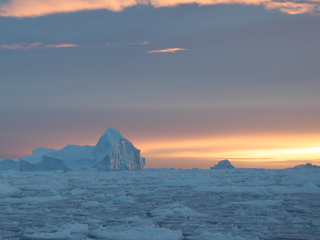Polar Geography
The Arctic and Antarctica: Two Different Worlds
Literally on opposite ends of the earth, the Arctic and Antarctica are vast, icy, and cold, but beyond that they’re very different. Antarctica, in the south, is a continent surrounded by ocean; the Arctic is an ocean surrounded by continents. There are no native people in Antarctica (but lots of research scientists); the Arctic’s native populations stretch back for centuries. And unless you’re at a zoo, you’ll never see a polar bear and a penguin living in the same neighborhood. Polar bears live only in the Arctic; penguins live in Antarctica, and other parts of the Southern Hemisphere. Some of the major differences between the two regions are listed below.
| Natural Features | |||
| Antarctic | Arctic | ||
| • | Continent surrounded by ocean | • | Ocean surrounded by continents |
| • | 97.6 percent of land ice is covered in an almost unbroken South Polar ice sheet |
• | Land ice is in limited areas; the largest is the Greenland Ice Sheet |
| • | Icebergs are derived from glaciers and shelf ice year round | • | Icebergs are derived from glaciers, seasonally |
| • | South Pole mean annual temperature: -58 degrees Fahrenheit |
• | North Pole mean annual temperature: 0 degrees Fahrenheit |
| Plants and Animals | |||
| • | No tundra, no tree line | • | Tundra well developed, extensive, and marked by a tree shrub line |
| • | No terrestrial mammals | • | Terrestrial mammals including polar bears, ox, reindeer, caribou, lemmings, and more |
| • | About 18 bird species (including penguins) | • | About 107 bird species (but no penguins) |
| Humans | |||
| • | No record of primitive humans; no native groups | • | Native peoples with long, rich cultural record |
| • | Population south of 60° S. latitude sparse, scattered at scientific stations |
• | Human population 60° N latitude in excess of 2 million; modern settlements, widespread exploitation and technological development |
| • | Crossing of Antarctic Circle by James Cook, January 17, 1773 | • | Crossing of Arctic Circle, prehistoric |
| Adapted from: United States National Science Foundation. “The United States in Antarctica: Report of the U.S. Antarctic Program External Panel.” 1997 [Washington, D.C.] | |||










